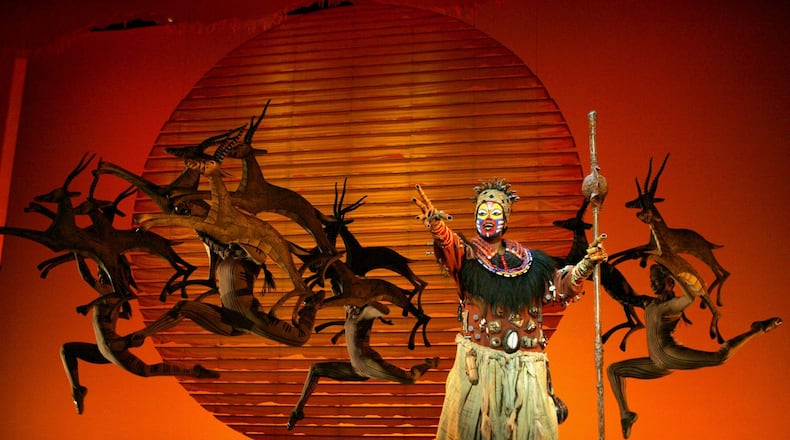With the masks, Taymor created what she calls “the double event,” which enables the audience to see the characters as animal and human at the same time. In particular, the actors portraying Scar and Mufasa each wear two different masks: one moves and one is a stationary headdress.
Peter Hargrave, who portrays the villainous Scar, has the unique responsibility of operating a mechanical mask while speaking, singing and sauntering across the stage with sophistication, wit and treachery.
“My costume requires five mechanical boxes and batteries that are hidden inside the costume,” Hargrave said. “There are wires that run up my back which end up in a remote control in my hand that mask the mask go forward and back. It’s a heavy costume as well. It weighs 32-and-a-half pounds, and it requires four different departments to help me get dressed. The people that are in this show are as much athletes as they are actors.”
Credit: CONTRIBUTED
Credit: CONTRIBUTED
Hargrave, a Texas native, joined the tour in August 2022. He said he had nearly five weeks of rehearsal in order to master the puppetry components.
“Scar is a dichotomy of movement,” Hargrave said. “I’m trying to make it seem like it’s all body weight-generated when it’s actually coming from a remote control in my hands. To be honest, all of the puppeteers in this show are still figuring new things out every single day, which is part of the great fun of being in ‘The Lion King.’”
For over 25 years, the aforementioned Curry, based in Portland, Oregon, has worked widely as a visual and concept designer for numerous companies including Disney Theme Parks and Theatrical Productions, Cirque du Soleil, The Metropolitan Opera, seven Olympics Opening and Closing Ceremonies, Universal Studios Theme Parks and many others. In the music industry he’s known for his innovative designs for Michael Jackson, Katy Perry, Lady Gaga and countless others.
During the conceptualization process of creating Scar, he said he purposefully wanted the puppetry to occasionally take precedence in order to fuel the drama.
“I wanted the puppet, at times, to overtake the human actor and the face,” Curry explained. “We spent a lot of time making Scar look dangerous. He’s all prickly. Everything looks like a weapon on his costume. Scar goes from cheeky to menacing. The silhouette change, in which the motors that drive the mask forward are done in concert with Peter’s motion, is very powerful. Scar’s confrontation with Mufasa is one of the most symbolic moments. It goes from light entertainment to serious Shakespearean drama in an instant.”
‘An homage to African art’
Mufasa’s mask weighs 11 ounces, Scar’s mask weighs seven ounces and Sarabi’s mask is just four ounces. The masks, along with many others used in the show, are extremely lightweight (just under one pound) and are comprised of silicone rubber (to form the mask imprint) with carbon fiber overlay — the same durable material used to build airplanes. Over 750 pounds of silicone rubber were used to make the masks.
Curry noted the significance of honoring the African esthetic as he and Taymor formulated their remarkable vision.
“We emulated the look of certain African styles of masks, and in other cases, we took the styles we were learning from traditional African art and applied them to the characters,” Curry said. “So, this is why Scar is angular. Scar is a series of angles and very asymmetrical. Scar has a nasty side and a nastier side whereas Mufasa is perfectly symmetrical. Mufasa’s headdress looks like a radiating sun. It’s absolutely stoic and doesn’t have the melodrama built into it like Scar. "
Credit: DISNEY THEATRICAL PRODUCTIONS
Credit: DISNEY THEATRICAL PRODUCTIONS
During the infancy of “The Lion King” process, he recalls being influenced by the South African music of composer Lebo M, which provided the emotional and fundamental groundwork for what the show would become.
“When Julie and I heard his music we found our way,” Curry said. “We knew we wanted to honor the spirit of his music. We were also looking for an authentic way to get into this African story and the music allowed us to do that. We knew the music would carry the show as much as the visuals. ”
He also acknowledged some elements of his designs incorporate Japanese and Turkish sensibilities but the African perspective is paramount.
“The joy of the show is that it doesn’t take a stance at one style or technique but you can see across the board that there is an homage to African art,” Curry said. “We are unashamedly influenced by that.”
‘This story is rooted in family’
The production contains familiar songs from the film written by Academy Award winners Elton John and Tim Rice such as “Circle of Life,” “I Just Can’t Wait to Be King,” “Hakuna Matata” and “Can You Feel the Love Tonight,” but Lebo M’s spirited, African-flavored contributions to the score include “They Live In You,” “One By One,” “Shadowland” and “Endless Night.” Also, the tour travels with 12 musicians who play over 80 different musical instruments from all over the world. Among them are 55 different drums and percussion instruments as well as 13 flutes.
In addition to Hargrave, whose credits off-Broadway and regionally include Cleveland Play House, Actors Theatre of Louisville, Cincinnati Playhouse in the Park, and Disney Cruise Line, the principal cast includes Gerald Ramsey as Mufasa, Mukelisiwe Goba as Rafiki, Nick Cordileone as Timon, Nick LaMedica as Zazu, John E. Brady as Pumbaa, Darian Sanders as Simba, and Khalifa White as Nala.
Credit: Uncredited
Credit: Uncredited
Hargrave, who fondly recalls seeing “The Lion King” when he was 11, said the cast is fully aware of the show’s impact and magnitude having inspired generations of theatergoers for over 25 years.
“We say here the circle of life happens on stage every night, but it also happens in our audience,” he said. “We are so privileged to have people whose first show was ‘The Lion King’ who are now bringing their kids to the show as their first show. It’s really special. And this story is rooted in family, family you are born into and family you choose along the way. Because of the excellence portrayed on stage, we really believe when people see this show they can go out and be the best version of themselves.”
‘THE LION KING’ BY THE NUMBERS
· Puppets including rod puppets, shadow puppets and full-sized puppets: 200
· Number of cast members needed to bring those animals to life: 49
· Ants on the Ant-Hill Lady costume: 40
· Wigs: 45
· Wildebeests: 22
· Hyenas: 39
· Types of animals, birds, fish and insects represented in the show: 25
· Gazelles: 15, five actors each wear a gazelle puppet on both arms and one affixed to their head.
· Gazelles on the gazelle wheel prop: 6
· Lionesses: 14 (Nala, Young Nala and 12 ensemble in the ‘Lioness hunt’).
· Bird Kites: 12, featured in “One By One,” the opening number of Act II.
· Bird Ladies: 5
· Bird Man: 1, he appears in “Circle of Life” opening number and in the “Circle of Life” reprise in the final scene.
· Simba representations: 6 (Baby Simba puppet, Young Simba-actor, Young Simba puppet, Simba Shadow puppet, Rafiki’s Simba painting-Act I & II, Adult Simba-actor).
· Zebras: 3
· Crocodiles: 3
· Elephants: 2 (they are “Bertha” and the Baby Elephant who is operated by the child actresses alternating the role of Young Nala).
· Antelope: 2
(In the opening number, the low and high antelope are the first animals Rafiki calls out to in Swahili – the ‘NGONYAMA’ call and response choral chant. The antelope are portrayed by two South African male ensemble singers.)
· Rhinoceros: 1
· Cheetah: 1
· Other animals represented include guinea fowl, buzzards, fireflies, mice, ants and unspecified birds and fish.
HOW TO GO
What: Disney’s “The Lion King”
Where: Schuster Center, 1 W. Second St. Dayton
When: May 1-12; 7:30 p.m. Tuesdays-Thursdays, 8 p.m. Fridays, 2 and 8 p.m. Saturdays, and 1 and 6:30 p.m. Sundays
Cost: $44.50-$175
Tickets/more info: 937-228-3630 or daytonlive.org
About the Author





